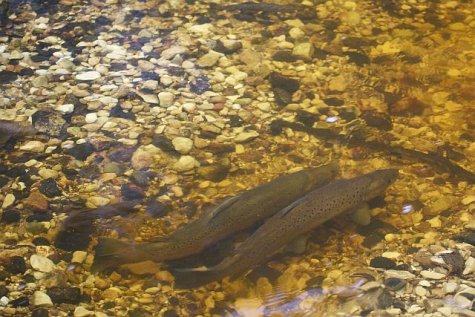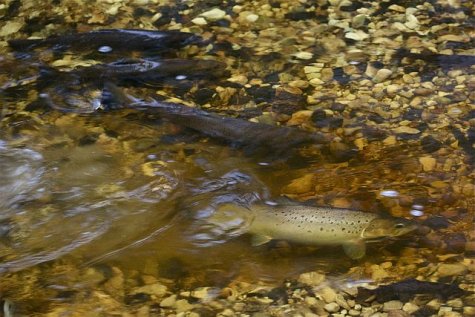At sea trout spawning grounds
Photos: Tiit Hunt
Translation: Liis
Male sea trout to the left
|
Sea trout |
Meriforell |
We took a look at how the sea trout have accepted the artificial spawning sites. The work has turned out to be gratifyingly useful.
Sea trout started to head upstream in rivers in August-September when there was enough water in the estuaries; westerly winds that raised the sea water level considerably contributed to that.
First-time egg-laying female trout are three years old, and about forty-five centimetres long; young male fish with milt are the same age. In the spawning of larger fish it is not surprising that females may be bigger. The female digs a nest furrow or trough at least twice its own body length in a gravelly bottom that is well permeable for water and is well provided with the oxygen needed for the development of the eggs. The eggs are laid there and the male fish fertilises them with its milt. The nest furrow is covered with gravel and the lighter area on the river bottom remains easy to see. A female spawns in several stages and for a number of days. Nevertheless up to a third of the roe is lost – the flow of water washes it out of the nest trough or a later spawner considers the same spot as the one and only suitable one …
There are many competitors for the washed-out roe – the spawning is surveilled by river trout, young sea trout – about a year and a half old - that live in the river, and for instance burbots if they live in the same river. Scientists have not noticed direct looting of the nest troughs – the species has to be preserved after all.
In the spawning sites spawning pairs can be seen; they are surveilled by two-three so called dwarf males and sea trout or river trout, generally more than four individuals. With the low water level this year it is easy to watch what goes on.
A number of interested parties move on the river banks, not all of them with the best of intentions. We were checked three times in the course of a few hours – our thanks to the conscientious Environmental Inspectorate and RMK (State Forest Management) inspectors.
One final request: if you notice any suspicious doings at river banks please call the Environmental Inspectorate’s round the clock emergency hotline, 1313.










